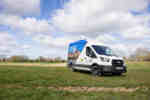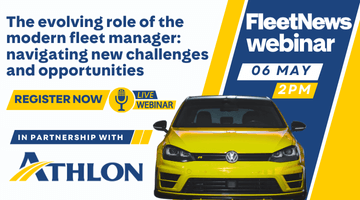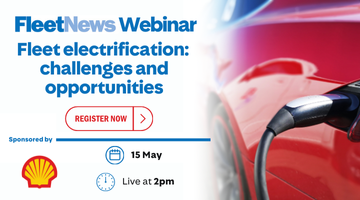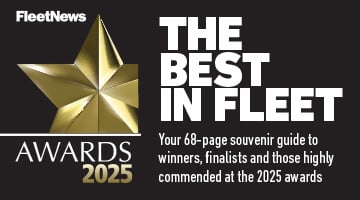The Government has made no bones about the fact that it is turning the spotlight on health and safety among fleet drivers and is looking for a high profile company to prosecute under its corporate manslaughter legislation (explain).
From my travels and talks among Britain's van fleet operators, it is pretty clear to me that most are either ignoring the threat or sticking their heads in the sand, hoping it will go away.
Well, the news is that health and safety is an issue which won't go away – nor should it – and those who choose to ignore it may live to regret it.
The problem is that health and safety costs money. It either means vehicles will cost more to buy or drivers will not be so productive. As van fleet operators are notorious for their reluctance to open their wallets, it is hardly surprising that the plea has so far fallen on deaf ears.
With this in mind, Fleet Van is dedicating this issue to health and safety in a final effort to open the van fleet world's eyes to a problem which should - and must - be tackled.
Let us assume for a moment that the reader is a van fleet operator who has never even stopped to think about his vans and staff, let alone implementing a health and safety audit. All he considers are front end price, how to get the most from both vehicles and drivers and finally how much profit they produce.
Reading this article and miraculously stricken by some pang of guilt (some hope!) he cries: 'But where do I start?'
The answer is: right here
First and foremost, we must separate the various facets of health and safety as they are many. Not all will need to be addressed but all must be considered.
Health and safety is a vast subject and may seem at first be be a daunting one. But split it down into bite-sized chunks and the task becomes easier.
For starters, health and safety can be split into two main areas – vehicles and their drivers – and then each of these two sub-headings can be divided again into smaller areas of concern.
So let's take each step at a time...
Action plan – vehicles
For the H&S-conscious van fleet operator, there is work to be done even before a vehicle is ordered. First question to be asked is: 'Am I actually buying the right van in the first place?'
It may sound absurd but many operators pick models which are unsuitable for their particular needs. For example some buy short wheelbase Transit vans when the smaller Transit Connect would do. Such folly not only wastes money but also raises the spectre of compensation claims from a driver who injures his back by having to lift loads off the ground further than is necessary. Don't forget that Britain is fast following America down the 'if it moves, sue it' route.
Also, if your fleet is likely to carry long loads, make sure your vans are long enough to accommodate them. A protruding object from the back or side of a van could catch a pedestrian and cause injury, as in the case of Karl Totterdell, who killed a passing pedestrian by a plank of wood which was sticking out of the side of the van. He was sentenced to 18 monsths in prison for causing death by dangerous driving.
Imagine the scenario where the blame for a similar incident was passed on to the fleet operator because the driver was forced to carry loads in a van which was unsuitable. Scary, eh?
Safety organisation BRAKE offers a free pamphlet giving advice on load safety. Call 01484 559909 for a copy or email ncossins@brake.org.uk
Having established that the vehicles you are ordering are in fact the correct ones, we then turn to the thorny question of paid-for options – and the fun really begins.
Most van ranges nowadays come as a basic box and cab on wheels with an amazing array of add-on extras available so the van operator can tailor his fleet exactly to his particular needs.
Amazing though it may seem, the vast majority of heavy panel vans come with a driver's airbag as a paid-for option. The Ford Transit is the notable exception. It's a topic that I've been hammering away at for months now, but so far the other manufacturers have declined to join Ford in this basic safety move. More worrying, when I have questioned these manufacturers on why they don't offer a standard airbag, they say that fleets don't want them. I can only concluded from this that most of the UK's operators don't give a damn about health and safety, a disgraceful state of affairs.
Next – and probably just as important – are ABS brakes. Both Transit and Volkswagen LT offer these as standard, along with some of the smaller panel vans such as Renault Trafic, VW Transporter and Mercedes-Benz Vito (CHECK). But if you decide to provide ABS brakes, make sure your drivers know how to use them – believe it or not many don't.
I well remember an incident not so long ago when one of our secretaries came in from driving a test car and yelled at us that the brakes didn't work. She had apparently slammed her foot on the pedal and – feeling the pedal give way slightly as the ABS cut in – yanked the handbrake on too as she thought the brakes had packed up.
Any driver training company which offers LCV courses (more of which later) will be happy to oblige with a special ABS programme.
Further down the options list are items such as self de-icing windscreens, air conditioning, reversing alarms and electric windows. Don't dismiss these out of hand. How many drivers do you see thrashing down the road dangerously with their screens covered in ice? And in the summer, surely a driver cooled by an aircon system is a safer driver. Reversing alarms are a relatively cheap fitting and once you get used to them, you'll wonder how you ever did without them. They will avoid the possibility of a driver reversing over a passing pedestrian and are well worth consideration.
In my view, airbags and ABS brakes are NOT an option – they are a must. Imagine the scene in a civil court when you are facing the judge after one of your drivers has been left in a wheelchair after an accident and he is claiming compensation.
The judge discovers that you could have chosen a van with a driver's airbag but you didn't because you wanted to save a few quid on the front-end price of the vehicle. The thousands of pounds the judge was going to award the driver start looking more like millions. Scary again, eh?
One way of making sure drivers behave themselves is by fitting telematics systems to vehicles. Things start getting very pricey but as technology progresses at a rate of knots the cost is coming down and the systems are getting better. I don't intend to go into depth about vehicle tracking as that is a subject which deserves its own feature in Fleet Van.
Suffice to say that telematics systems can keep an eye on the speed your drivers are doing, the hours they work and the places they visit. Many systems can be linked up to a desktop PC and can provide a mass of information. Generally the more you pay the better they are. My only advice here is to beware of the firm which only offers one product. The salesman may well convince you wrongly that this product will suit your needs. By the time you've paid for it and find it doesn't it is too late to change.
If your drivers really are an uncontrollable rabble, it may be an idea to fit speed limiters to your vehicles. That way they won't be able to exceed the speed limits even if they want to. If that doesn't work, the sack seems to be the only alternative!
OK, so your brand new, properly-specced vans have arrived. What next?
The main concern on the health and safety front is that they must be maintained properly. Most van drivers don't seem to bother about oil and coolant levels and tyre pressures so make sure that one person is responsible for such checks on each vehicle. This should ensure that vans are not involved in accidents due to lack of air or oil. Once again a driver (or an injured third party) could sue you if you didn't take proper steps to keep a check on maintenance.
Also you should ensure that service intervals are not exceeded. There is some excellent fleet software available which will alert you to when each vehicle is due in at the garage for a check-up.
Action plan – drivers
Now let's start turning towards the drivers of your vehicles. It is hardly surprising that white van man has such a terrible reputation. Many are underpaid and overworked and are therefore likely to be oiks who don't care about their vans or other road users.
If I was a van fleet operator I would expect to pay a fair day's wage for a fair day's work – and as such would expect the best from my drivers. Unfortunately many operators don't seem to see that cheapest is not always best.
Before you take on a new driver, insist on looking at his driving licence and ask for references from a previous employer. If he can't provide either, send him on his way. Once taken on, check on driving licences at least every six months to make sure endorsements haven't crept on without your knowledge.
A driver's handbook is essential, as errant employees will have no excuses about breaking the rules. You can then discipline them without the risk of them claiming they didn't know.
Alert your drivers especially to the laws regarding driving – for example, they must wear seatbelts and mist nmot use mobile phones while on the move. Make it a sackable offence and you might just getb them to toe the line.
Many operators buy 3.5 tonne gvw vans because they are the bioggest vehicles which can be driven withouyt a tachograph. The inference here is that many van drivers are expected to spend too much time behiund the wheel. Sorry, but this is no longer acceptable and steps should be taken to make sure that striuct hours are adhered to.
It will, of course, mean that productivity among drivers is not what it wasa, but that – as they say – is the way the cookie crumbles. What was accptable in 1963 is no longer acceptable in 2003. If drivers can't be trusted to stick to their hours, fitting of the aforementioned telemtaics systems should do the trick.
Recent research into the white van man phenomenon by Renault showed that only 5% of van drivers had been given any sort of specialist driver training – a shocking but hardly surprising figure.
Driver training is s tricky subject as, unlike the fitting of telematics systems, there is no obvious end result. You may have a job persuading your bosses to cough up the necessary cash. Driver training firms would argue that the cost of training will be recouped by a corresponding drop in accidents but trake care before committing you company's money to training.
Look into the possibility of training just the worst drivers – the better ones may not need it.
















Login to comment
Comments
No comments have been made yet.